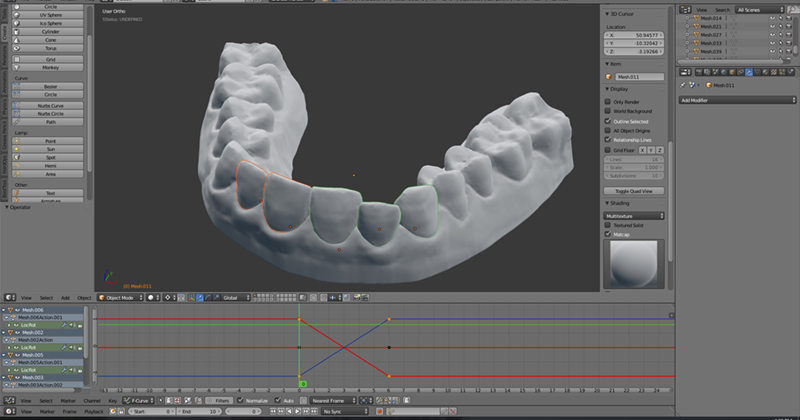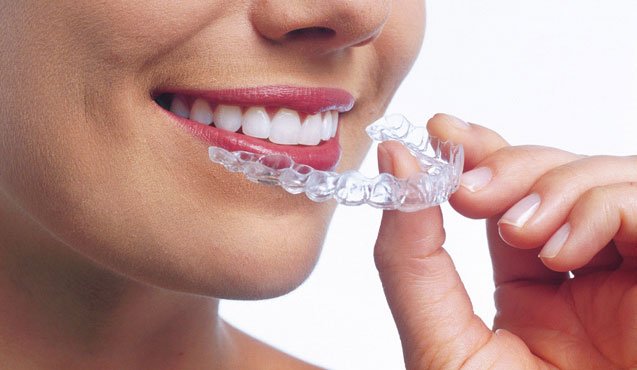The future of orthodontics
This article was translated from an article on the Dental Correct website. Dental Correct is a dutch dental practise specialised in Invisalign and clear braces. The article was written in association with William Pen a digital strategist from Amsterdam.
There are many techniques available for the straightening of teeth. One of them is the invisible braces made by Align, Invisalign. The company manufactures custom braces based on a 3D scan of the teeth which is done by a dentist or orthodontist. The 3D scan is made into a model which will be analysed by the company. Based on this analysis multiple sets of braces are then manufactured for specific time frames of the treatment. By wearing the different sets of aligners and changing them for instance every two weeks, the teeth will be aligned over time.

In this day and age many markets get disrupted by technology like artificial intelligence, 3D printing and apps. Could it be possible that a combination of these technologies will make the orthodontist redundant in the near future?
Student prints his own braces
Just a year ago Amos Dudley a digital design student at the New Jersey Institute of Technology went viral on the internet because he made his own set of invisible aligners for less then $60 and straightened his teeth without the help of an orthodontist. Dudley did research on orthodontic procedures and made a mould of his teeth using alginate powder. He then scanned the teeth and used software to digitally model the progression of his teeth towards his goal.
He needed to digitally separate the teeth and plan the route that every tooth should make to get into the right position without intersecting with each other. He measured the total distance of teeth movement and divided it by the maximum recommended distance a tooth can travel per aligner.
After finishing the 3D models of all the aligners Dudley printed his braces with a Statasys 1200es 3D printer at his university. After he finished the prints he used a vacuum form machine to create the plastic aligners. The dental plastic material used for the aligners he bought on eBay.

Technology and the future
Currently the technology is not developed enough to make braces at home. The resolution of home 3D printers is inaccurate so it isn’t possible to print dentist quality aligners at home. Furthermore most people don’t have the time to do all the research Dudley invested to create his braces. Also they won’t have the skill or materials to create a mould of their teeth.
But in 5 to 10 years a mix of artificial intelligence, 3D printing and smart smartphone applications will change all this. It’s already been made possible to make a full 3D model of the face by only using one photograph. Cameras in smartphones and smartphones themselves become more sophisticated every day. So it is plausible that a smartphone application will be capable of rendering an exact and high quality 3D scan of the mouth based on a set of 4k images captured by the patient at home.
X-rays
In order to make a diagnosis it is important to make x-rays for pathology and skeletal analysis. With the X-rays, mouth pictures and a digital scan you have the complete information for a treatment plan. There is a lot of research done on replacing x-rays for saver and more portable technologies. The company Scandx already makes x-ray like images to identify bone fractures using soundwaves. Other research groups look at a technique borrowed from astronomy called adaptive optics to calculate how light travels through an object. When these techniques get more advanced and cheaper to manufacture they will most likely be included in smartphones or be adapted so they can be used with standard smartphones for instance by using a combination of light and sound to make x-rays.
Deep machine learning
Deep machine learning is already used for analyzing and interpreting X-rays and CT images. An algorithm made by a south Korean based company called Lunit is already analysing and interpreting medical X-rays and CT images with an 95 percent accuracy. Which is much higher than most doctors who have accuracy levels below 80%. With the current level of technology in deep learning it should already be possible to feed a deep learning algorithm thousands of orthodontic scans and treatments animations from previous patients. Based on its learning path, the X-rays and high resolution photos of the mouth this deep learning algorithm would then be able to give an accurate treatment plan for new cases which it could model into a 3D animation that can be converted into different sets of braces.

3d printers
3D printers are not something people have at their homes. The question is what the future of 3D printing will hold. 3D printers from the future will most likely be able to print a lot of things we order online or buy at bricks and mortar stores today. Those printers might even be able to print dental aligners. But until this is possible there can be specialized 3D printers at your pharmacy, doctors clinic, or maybe even your local makerbot store where the braces can be printed on the go.
Remarks on Dudley's treatment
Dudley had a slight deviation of his teeth, only little corrections were needed to optimise his occlusion. These small movements could be easily performed without any complications. In more advanced and complex cases the experience of a dentist or orthodontist is needed. For example, if a root canal treatment is present in a tooth there is a possibility of root resorption after orthodontic movement. Also movement of teeth with excessive force could lead to recession of the gums. Even bone resorption can occur by moving teeth in a faulty way. If the orthodontic end result is not optimal and the patient's occlusion is not stable relapse can be result.
The material that Dudley used to print can be toxic. Braces have to be worn for at least 22 hours a day. If the material is toxic there are general health risks, for example an allergic reaction. Align uses a well researched special type of plastic that is 100% safe. Doing your own treatment at home is not safe and we recommend to go to a dentist for an intake and diagnosis. Furthermore, more research needs to be done on 3D printing, artificials inteligence and home x-rays.
So is it possible?
The current level of technology in 3d printers is already on a level that can be able to effectively print 3d braces on location at a dentist or pharmacy. Deep learning and artificial intelligence are also ready to learn from existing treatment plans and generate treatments for future cases. State of the art photo technology can be used to make advanced 3d scans from the mouth and teeth already but the technology will become more advanced in future smartphones. The most important factor why its still not possible to analyse the anatomy of the teeth with material that is made by the patient at home is the x-rays. Research around the subject of alternative to x-rays is delivering more and more useful results so there a big chance that 5 years from now it might be possible to have your teeth straightened without the need of a dentist or orthodontist.
More on orthodontics for grownups and invisible braces by Invisalign can ben found at: Dental Correct.
Congratulations @williampen! You have completed some achievement on Steemit and have been rewarded with new badge(s) :
Click on any badge to view your own Board of Honor on SteemitBoard.
For more information about SteemitBoard, click here
If you no longer want to receive notifications, reply to this comment with the word
STOPThanks for your good posts, I followed you!
thanks for the follow
Congratulations @williampen! You have received a personal award!
Click on the badge to view your Board of Honor.
Congratulations @williampen! You received a personal award!
You can view your badges on your Steem Board and compare to others on the Steem Ranking
Vote for @Steemitboard as a witness to get one more award and increased upvotes!